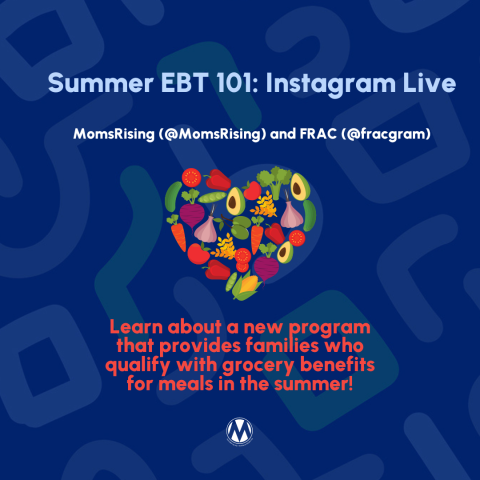
What is the Summer Electronic Benefit Transfer (EBT) program (also known as SUN Bucks) and who qualifies for it? I had the pleasure of speaking with Kelsey Boone, the Senior Child Nutrition Policy Analyst at FRAC, on all things Summer EBT and how you can access this nutrition assistance program for your family!
Let’s recap our conversation over Instagram Live on this critical nutrition program:
- Let’s start with an overview of what the summer EBT program is. How can this program get assistance to families to help out with summer grocery costs?
Summer EBT is a new nutrition program for families that provides a one-time payment of $120 in federally funded grocery benefits (benefits are slightly higher in Alaska, Hawaii, and the U.S. territories) on an Electronic Benefit Transfer (EBT) card for each school-age child who is eligible for free or reduced-price school meals to help replace free and reduced-price school meals. This program was authorized by the Consolidated Appropriations Act of 2023 as a permanent, nationwide program beginning this summer - What states are participating in this program this year? Who is eligible for the 2024 Summer EBT program?
Most states are participating in the Summer EBT program this year, however, the following states are not: Alabama, Alaska, Florida, Georgia, Idaho, Iowa, Mississippi, Oklahoma, South Carolina, South Dakota, Texas, Utah, Vermont, and Wyoming. The District of Columbia and all the territories are also participating. Additionally, The Cherokee Nation and The Chickasaw Nation are participating this summer and will be providing benefits to members of other Tribes and non-Tribal members in neighboring areas as well.Children are considered automatically eligible if their household receives Supplemental Nutrition Assistance Program (SNAP, also known as food stamps), Temporary Assistance to Needy Families (TANF), the Food Distribution Program for Indian Reservations, or Medicaid (families must also have a household income of 185 percent below the poverty line and participate in Medicaid) as well as if they are homeless, in foster care, a migrant, or in Head Start. Eligibility also includes school-aged children who do not attend a school that participates in a national school lunch program and can be directly certified (including those who are homeschooled or attending virtual schools).
Estimates show that 30 million children are eligible for Summer EBT in the United States! Head over to the USDA’s landing page for Summer EBT to have more information on eligibility for this program.
- Who needs to apply for Summer EBT? How do families apply for the program? What info do they need to have ready when they do so?
Most eligible children do not need to apply for Summer EBT benefits! You must submit an application for Summer EBT if:
- Your child(ren) attends a school that offers free meals to all students (through community eligibility or Provision 2 or 3) and does not fall into one of the categories above.
- Your child(ren) attends a school that participates in the National School Lunch or Breakfast Programs but was not qualified for free or reduced-price school meals during the school year. This could be because you did not submit a school meal application during the school year, or your child became eligible during the summer.
Please have your child’s school information and your income information on each member of your household when filling out an application. If your family needs to apply for this program, visit your state’s website or head over to the USDA’s Summer EBT Online Application hub to learn more! - Where is the Summer EBT card eligible to be used?
The Summer EBT card can be used at any grocery stores and food retailers that accept SNAP benefits. It can also be used at farmers’ markets that accept SNAP.
- Is there anything else families should know about this program?
Summer EBT does not impact you or your child’s immigration status (the public charge rule does not apply to Summer EBT benefits). In addition, if your state is not participating this year, they can decide to participate in the summer of 2025 or after. Reach out to your governor to urge them to adopt a program or to your state’s anti-hunger organizations to see how to move your state forward.
Watch the entire Instagram Live conversation below! For more information, head over FRAC’s Summer EBT page and FRAC’s Summer EBT Eligibility Guide.



The views and opinions expressed in this post are those of the author(s) and do not necessarily reflect those of MomsRising.org.
MomsRising.org strongly encourages our readers to post comments in response to blog posts. We value diversity of opinions and perspectives. Our goals for this space are to be educational, thought-provoking, and respectful. So we actively moderate comments and we reserve the right to edit or remove comments that undermine these goals. Thanks!